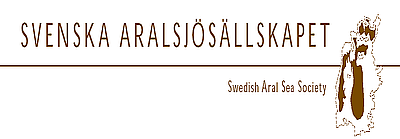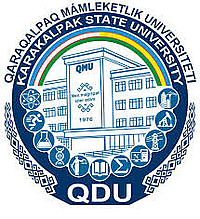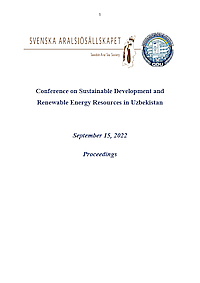 Proceedings: Conference on Sustainable Development and Renewable Energy Resources in Uzbekistan
Proceedings: Conference on Sustainable Development and Renewable Energy Resources in Uzbekistan
September 2022
The conference was organized as a common effort among the Uzbek universities taking part in the master level course on Sustainable Development and Sustainability Science during February to June 2022 organized by the Swedish Aral Sea Society and Karakalpak State University. The topic chosen for the conference was a key question for achieving a sustainable society, energy, especially in the present situation of global warming in which the Central Asian republics are especially hard hit.
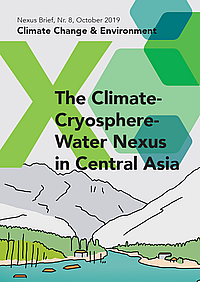 Melting glaciers in Central Asia
Melting glaciers in Central Asia
Overview by Bo Libert, October 2020
Climate change is contributing to considerable changes with regard to how much water is found in glaciers in Central Asia. It is particularly in the upstream countries Kyrgyzstan and Tajikistan that glaciers are found. In the high mountains of Tien Shan and Pamir ice and snow can accumulate and
form glaciers.
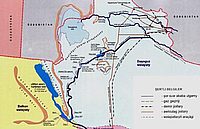
Altyn Asyr – The Golden Age Lake
Bo Libert, December 2020
Due to the extensive irrigation systems in Central Asia, there are places where there is too little water and other places where there is too much. New infrastructure has been built and is under construction to diminish the problems caused. Kok-Aral is a reservoir on the Syr Darya constructed by Kazakhstan to collect water in the winter for the Northern Aral Sea, the Sardobe dam on the same river that recently broke was built in Uzbekistan to collect water for irrigation and, of course, the Rogun dam constructed in Tajikistan on a tributary to Amu Darya mainly for energy purposes.
 New Initiatives in the Aral Sea Region
New Initiatives in the Aral Sea Region
Bo Libert
Over the past years, new thinking is evolving in the Aral Sea region to counteract the environmental catastrophe – or at least to develop some positive initiatives that the local and international community can gather around to improve the living conditions in the area.
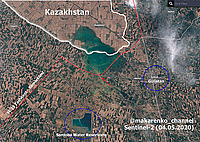 The Sardoba Dam Accident
The Sardoba Dam Accident
Bo Libert, May 2020
1 May 2020 the first dam accident in Central Asia with a significant transboundary impact took place. A dam in Uzbekistan under construction – the Sardoba dam - broke and large areas including newly sown agricultural land were flooded in Uzbekistan as well as Kazakhstan. Heavy rain and a storm were claimed to be the reason, but it is evident that the dam construction was not solid enough.
1. Regarding the dam accident in Uzbekistan with consequences in Kazakhstan, the countries have now established a "roadmap" to develop water cooperation. Kazakhstan and Uzbekistan have many common problems, but the latter, who are upstream, have not wanted to share either water or information. This despite the fact that both countries are parties to the ECE water convention with subsequent obligations to cooperate. We can only hope that these plans for improved cooperation will be realized. Kazakhstan, for example, wants cooperation on water quality, which would be a big step forward for the region.
2. Below is an interesting picture of the development regarding the water flow as a consequence of estimated climate changes.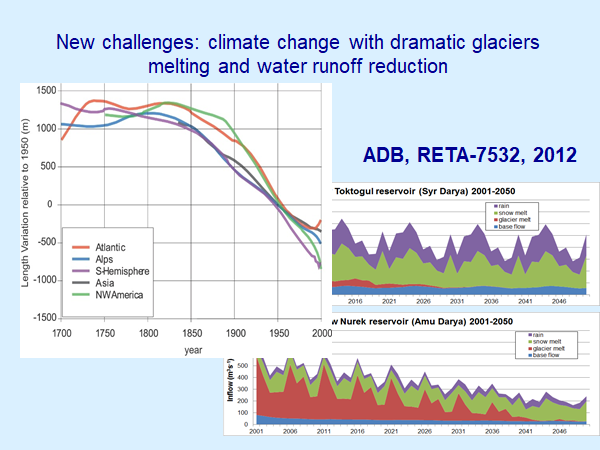
I would particularly like to point out the red fields in the graphs on the right which show the proportion of the water flow coming from glaciers up in the mountains and within a few decades disappearing completely. Water from the glaciers is particularly important for irrigation because this water melts off during the summer mainly.
3. We have mentioned Lake Balkhash in Kazakhstan. Below is a small piece I wrote and I am also attaching for information a longer article by Bulat Yessekin, an enthusiast with innovative ideas working on the watershed issues.
Lake Balkhash is one of the largest lakes in Asia and 15th largest in the world. It is located South of Almaty in Kazakhstan and belongs to a basin shared by Kazakhstan and China. The primary inflow is from the Ili River with its origin in China's Xinjiang region. The 8000 km2 Ili delta is a unique natural marshland and the lake is a Ramsar site very rich in biodiversity.
Lake Balkhash is now the largest freshwater lake in Central Asia after the shrinkage of the Aral Sea over recent decades. The lake is divided by a strait into two parts: a relatively deep, brackish eastern portion that is fed by several minor rivers, and a shallower, less salty western portion fed by the Ili River.
Like the Aral Sea, it is shrinking from the late 1900s as a result of the diversion of water, including from the Ili river. The Kapshagay reservoir and hydropower station was built on the Ili River in 1970. The filling of the reservoir impacted Balkhash seriously and the water level fell by 2.2 m and the volume was reduced, while the salinity of the western part increased. Also, as a result of a worsening water quality, the biodiversity is declining.
While the situation has temporarily stabilized, but the threat that the unique lake may deteriorate is still there. Increasing use of water for irrigation or other purposes, including in China, may ultimately cause another environmental catastrophe.
Bo Libert.
25 Years of Activities
International Fund for Saving the Aral Sea and New Impulses for Development of the Aral Sea Region
It is the title of a publication from Tashkent. It mainly deals with what has been done for the Aral Sea on the Uzbek side for the last 25 years. Vadim Sokolov is the main author. The publication contains a lot of interesting information, not least about what is happening locally in the Amu Darya delta.
 Centralasiengrupperna (CAG) is a Swedish organization that wants to promote a democratic Central Asia with a strong, active and inclusive civil society.
Centralasiengrupperna (CAG) is a Swedish organization that wants to promote a democratic Central Asia with a strong, active and inclusive civil society.
Centralasiengrupperna is a non-profit, volunteer-run organization that is politically and religiously unaffiliated. Our goal is to promote a democratic Central Asia with a strong, active, competent and inclusive civil society that contributes to human rights being respected, exclusion broken and social justice achieved. We do this through, among other things, long-term development cooperation, exchanges and training as well as advocacy work.
The focus of Centralasiengrupperna is the region of Central Asia mainly in the sense of the five post-Soviet republics of Kazakhstan, Kyrgyzstan, Tajikistan, Turkmenistan and Uzbekistan. Until recently, our projects have originated from Kyrgyzstan, but in the future other countries will also be involved. The Central Asian groups are a relatively young organization and therefore still in the building phase. Our aim is to become a natural platform for people who want to get involved in issues connected to the region - if you are interested in becoming active, there is a great opportunity to develop and create your own projects with us!
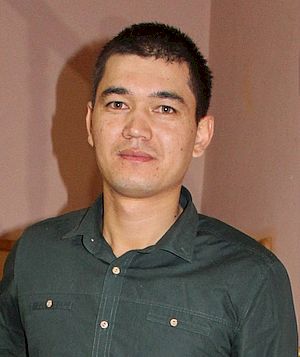 Akhmet Amangeldiev has written a report about his studies and four months in Uppsala. The report is called the Summary Report is written in English and is available for download.
Akhmet Amangeldiev has written a report about his studies and four months in Uppsala. The report is called the Summary Report is written in English and is available for download.
A big thank you to everyone who contributed money to Södra Strandfolken who made it possible for him to come to Sweden and Uppsala.
.
